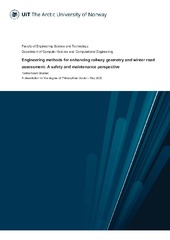Arctic Thin Sea Ice Thickness Regression Models for Sentinel-2
Permanent link
https://hdl.handle.net/10037/15758Date
2019-05-31Type
Master thesisMastergradsoppgave
Author
Skogvold, Øystein FredriksenAbstract
Sea ice thickness is an important parameter for modelling the sea ice mass
balance, momentum and gas exchanges, and global energy budget. The interest
of studies into thin sea ice has increased as trends in recent years show
a increasing abundance in thin first year ice. Existing thin sea ice thickness
products operate at resolutions down to 750 meters. Very high resolution (less
than 100 meters) retrieval of sea ice parameters is of particular interest due
to maritime navigation and model parametrization of physical processes at
meter-scaled resolutions that usually requires in-situ measurements.
The Norwegian Meteorological Institute provided a 500 meter resolution thin
sea ice thickness product developed by the Norwegian Computing Centre
for the Norwegian Space Agency’s "Sentinel4ThinIce" project. The product is
derived from Sentinel-3’s SLSTR sensor. Using overlapping multispectral optical
data from Sentinel-2’s MultiSpectral Instrument at metre-scaled resolutions,
we retrieved multiple regression models for thin sea ice thickness for Sentinel-2
data. The models included three univariate models for three different spectral
band combinations using non-linear least squares method, and one multivariate
model for three different band reflectance data-sets using a gradient boosting
regression tree.
The optical band reflectance data increased monotonically with sea ice thickness
and saturated for thicker ice, proving a clear correlation between thin sea ice
thickness and Sentinel-2’s band reflectance. The multivariate model produces
overall best results compared to the univariate models. The reliability of the
models couldn’t be trusted due to inaccurate atmospheric correction procedures
and not enough temporal and geographical variance in the data-set. Proper
calibration of Sentinel-2 data is of high priority in order to extend Sentinel-2’s
platform further into Arctic research.
Publisher
UiT Norges arktiske universitetUiT The Arctic University of Norway
Metadata
Show full item recordCollections
Copyright 2019 The Author(s)
The following license file are associated with this item:
Except where otherwise noted, this item's license is described as Attribution-NonCommercial-ShareAlike 4.0 International (CC BY-NC-SA 4.0)
Related items
Showing items related by title, author, creator and subject.
-
Engineering methods for enhancing railway geometry and winter road assessment: A safety and maintenance perspective
Brustad, Tanita Fossli (Doctoral thesis; Doktorgradsavhandling, 2020-06-22)In many areas around the world there are limited transportation possibilities when travelling between key cities. If these areas also experience demanding weather conditions or geography, getting from A to B, during difficult conditions, is usually not optimal in regards to accessibility, safety, and comfort. Under challenging conditions, two essential elements in strengthening accessibility, safety, ... -
Geometric Modeling- and Sensor Technology Applications for Engineering Problems
Pedersen, Aleksander (Doctoral thesis; Doktorgradsavhandling, 2020-10-20)In applications for technical problems, Geometric modeling and sensor technology are key in both scientific and industrial development. Simulations and visualization techniques are the next step after defining geometry models and data types. This thesis attempts to combine different aspects of geometric modeling and sensor technology as well as to facilitate simulation and visualization. It includes ... -
Iceberg Drift-Trajectory Modelling and Probability Distributions of the Predictions
Baadshaug, Ole (Master thesis; Mastergradsoppgave, 2018-06-29)Moving icebergs represent a major problem for shipping, as well as for oil and gas installations in ice infested waters. To be able to take actions against hazardous icebergs, it is necessary to develop models for prediction of iceberg drift trajectories. Many models have been developed in order to do so, using different approaches. These approaches can be divided into two main categories, dynamic ...


 English
English norsk
norsk



